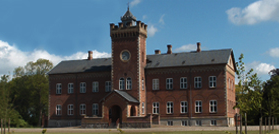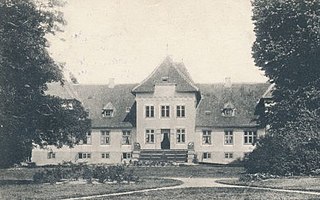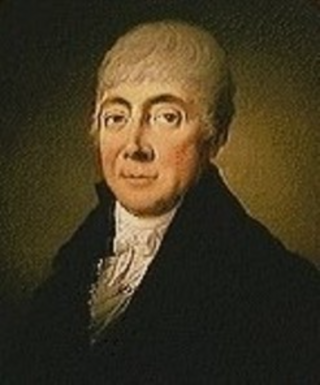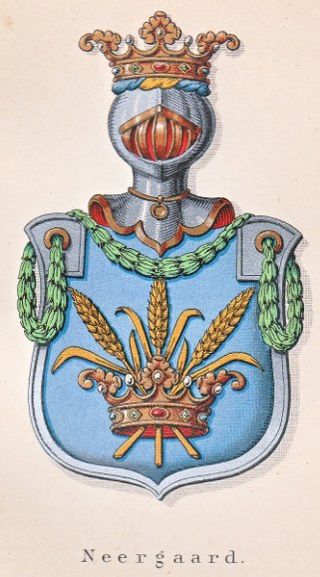
Slagelse is a town on Zealand, Denmark. The town is the seat of Slagelse Municipality, and is the biggest town of the municipality. It is located 15 km east of Korsør, 16 km north-east of Skælskør, 33 km south-east of Kalundborg and 14 km west of Sorø.

Slagelse Municipality is a kommune in Region Zealand on the west coast of the island of Zealand in Denmark. The municipality covers an area of 571 km2. The municipality borders Kalundborg Municipality to the north, Sorø Municipality to the north-east, Næstved Municipality to the south-east and connects to Nyborg Municipality via the Great Belt Bridge.

Antvorskov Monastery was the principal Scandinavian monastery of the Catholic Order of Saint John of Jerusalem, located about one kilometer south of the town of Slagelse on Zealand, Denmark.

Georg Hendrick Carl Koës (1782–1811) was a Danish philologist of the early 19th century.

Johan Christian Constantin Brun was a German-Danish merchant. Born in Germany, came to Denmark as Royal administrator of the trade on the Danish West Indies and in the same time built a successful private trading empire during the early Napoleonic Wars of the late 18th century, profiting on Denmark's neutrality.

Gyldenholm Manor is a manor house located 10 km south-east of Slagelse, between Gimlinge and Sørbymagle, Slagelse Municipality, some 70 kilometres southwest of Copenhagen, Denmark. The history of the estate dates back to 1774 but the current main building was constructed in 1864 to a Historicist design by Johan Daniel Herholdt. Gyldenholm covers 1,231 hectares of which approximately 500 hectares consist of agricultural land and 700 hectares of forest. Apart from agriculture and forestry, the estate derives its revenue from house rental and hunting rights. The main building is rented out for minor conferences, parties and other events. Gyldenholm was used as a location in the 1978 film Slægten.

Farumgård is a former manor house overlooking Farum Lake at Farum, Furesø Municipality, in the north-western outskirts of Copenhagen, Denmark. It is located just east of Farum Church and the original Farum village. The land has been sold off and redeveloped, except for the 6 hectares park which is laid out in the Baroque style.

Bonderup, also known as Bonderupgård, is a manor house located 16 kilometres (9.9 mi) south of Holbæk, Denmark. Nonderup and nearby Merløsegaard were purchased by the merchant Johannes Theodorus Suhr in 1852 and is now owned by the Suhr Family Trust. Bånderup and Merløse have a combined area of 1m310 hectares.

Hartvig Marcus Frisch was a Danish businessman who served as director of the Royal Greenland Trading Department from 1781 to 1816. The Frisch House, his former home in Copenhagen, located at Nytorv 5, was designed by Nicolai Abildgaard. It is listed on the Danish registry of protected buildings and places.
Svenstrup is a manor house and estate located close to Borup, Køge Municipality, some 50 kilometres southwest of Copenhagen, Denmark. It has belonged to members of the Neergaard/Wedell-Neergaard family since 1751.

The de Neergaard family is a Danish noble family descended from War Councillor Peter Johansen Neergaard, whose two sons Jens Bruun de Neergaard (1742–1788) and Johan Thomas de Neergaard (1745–1806) were ennobled on 31 May 1780. Descendants of Jens Bruun de Neergaard are referred to as the 'elder branch', whereas descendants of Johan Thomas de Neergaard are referred to as the 'younger branch'.

The Danish Constituent Assembly is the name given to the 1848 Constitutional assembly at Christiansborg Palace in Copenhagen that approved the Danish Constitution and formalized the transition from absolute monarchy to constitutional democracy. It consisted of members of which 114 were elected by the people, 38 were appointed by the king and the rest were government ministers.

Carl (de) Neergaard was a Danish landowner and politician. He was the owner of Gunderslevholm and Kastrup on central Zealand. He was a member of the 1848 Danish Constituent Assembly.

Tybjerggaard is a manor house and estate in the parish of Tybjerg, Næstved Municipality, approximately 80 km southwest of Copenhagen, Denmark. The Rococo-style main building was built for Tyge Rothe in 1653. It was listed on the Danish registry of protected buildings and places in 1918. The estate covers 475 hectares of land.

Falkensteen is a manor house located five kilometres south of Slagelse, Denmark. The current Neoclassical main building was built for Georg Frederik Ditlev Koës in 1775. It was listed on the Danish registry of protected buildings and places in 1950. A half-timbered barn from 1864 is also listed.
Valbygård is a manor house and estate located four kilometres northwest of Slagelse, Denmark. Created by Joachim Castenschiold in 1874 from land that had previously belonged to Antvorskov Abbey, the estate was in 1846 acquired by August Willads Bech and has since then remained in the Bech family. The current, Renaissance Revival style main building was built for August Willads Bech in 1855. It was listed on the Danish registry of protected buildings and places in 1996. The estate covers 1,100 hectares of land.
Store Frederikslund is a manor house and estate located eight kilometres northeast of Slagelse, Slagelse Municipality, Denmark. It is one of several estates that was established when Antvorskov Cavalry District was sold in public auction. It was established by General Hans Henrik von Eickstedt in 1783 and later owned by the Castenschiold/Grevenkop-Castenschiolds family from 1786 to 1995. The Neoclassical main building from the 1780s was probably designed by Andreas Kirkerup. It was listed on the Danish registry of protected buildings and places in 1918.

Fredsholm is a manor house and estate located close to Nakskov on the island of Lolland in southeastern Denmark. Fredsholm and Rudbjerggaard had the same owners in the period 1674–1819.
Idagaard is a manor house and estate located immediately south of Slagelse, Denmark. The estate was created by the businessman Constantin Brun from land that had previously belonged to Antvorskov and is named after his daughter Ida Brun. It is now owned by the Idagaard Foundation.
Christopher Schøller Bülow was a Danish landowner who served as prefect (stiftsamtmand) of Diocese of Zealand and county governor of Copenhagen County. He went bankrupt in 1818 and fled the country after being convicted of embezzlement. He died in Hamburg.


















